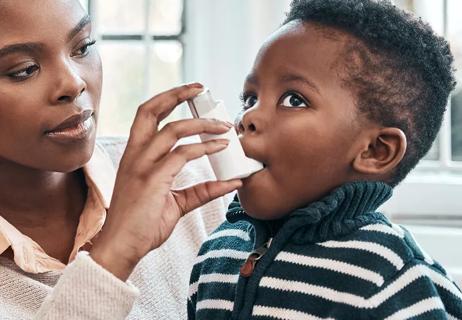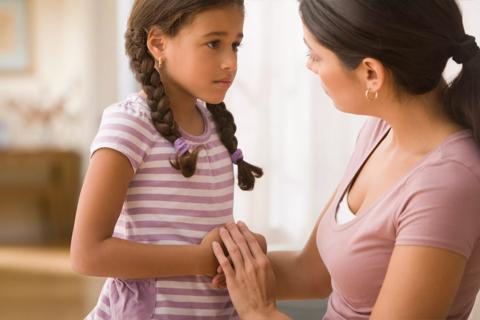An allergist can help you make a plan that includes information about what to do in case of an allergic emergency

If your child has a severe allergy, like a food allergy or an insect allergy, you probably work hard to keep them safe. But what can you do when they’re at school, where you don’t have the same kind of control over their environment that you have at home?
Advertisement
Cleveland Clinic is a non-profit academic medical center. Advertising on our site helps support our mission. We do not endorse non-Cleveland Clinic products or services. Policy
Allergist Sandra Hong, MD, explains why you need an allergy action plan, what that entails and how to make sure the adults in your child’s life know what to do in case of an allergic emergency.
An allergy action plan is a personalized document that outlines your child’s allergies and what to do if they experience an allergic reaction. Creating one for your child (and sharing it with the adults at their school) can help keep them healthy and safe when they’re away from home.
Here’s how to make one.
Before the school year begins, take your child to see a board-certified allergist, a doctor who diagnoses and treats allergies, asthma and immunologic conditions. They can:
“The allergist will put together an allergy action plan that identifies your child’s triggers,” Dr. Hong says. “They can also help your child better understand what causes their symptoms.”
If you live in the U.S. and your child has severe allergies, they may qualify for certain classroom accommodations under Section 504 of the Rehabilitation Act of 1973 (often just called “504 accommodations”). If your child already receives curricular accommodations, their allergy needs can be included in their Individualized Education Plan (IEP).
Advertisement
An allergy action plan created with your child’s allergist should include:
“As hard as you try, accidents may still happen,” Dr. Hong recognizes. “So, your allergist should carefully go over the allergy action plan with both you and your child.”
Want additional guidance on creating your allergy action plan? FoodAllergy.org offers a sample Food Allergy and Anaphylaxis Emergency Care Plan in both English and Spanish. It can be easily adapted for non-food allergies.
Once you have an allergy action plan, make sure the adults in your child’s life know about it.
“Share your child’s treatment plan with school staff, including administrators, teachers, the school nurse and cafeteria employees,” Dr. Hong says. Don’t forget about coaches and after-school caregivers, too! Make copies available to all of them, both in print and digitally.
Before summer ends, request an appointment to talk through the plan in person with your child’s teacher and/or school administrator. This way, they’re as protected as possible from the very start of the school year.
Information about how to deal with an allergy-related emergency should be included in your child’s allergy action plan. But it’s worth reiterating just how important it is to talk it through with educators and other important adults in your child’s life.
In the U.S., all 50 states have laws in place that protect students’ right to carry and use medications for asthma and life-threatening allergic reactions.
“Children who are at risk for anaphylaxis should have an epinephrine auto-injector, like an EpiPen®, to use to prevent the dangerous reaction that may be caused by allergies to certain foods or insect stings,” Dr. Hong says. “Be sure your child and school staff know how to use these emergency medications.”
Environmental allergens don’t typically cause anaphylaxis, so an allergy action plan isn’t usually needed. Still, if they’re not properly managed, they can make your child’s school days miserable.
Though many schools take steps to mitigate dangerous food allergies, environmental allergens often still lurk in school buildings and trigger allergic rhinitis in kids. Here are some of the most common:
Advertisement
“You may want to ask your child’s teacher or a school administrator if you can walk through the classroom ahead of the start of the school year so you can look for specific triggers,” Dr. Hong suggests.
Consider this: Unmanaged allergies and allergic asthma can affect your child’s academic performance or even translate into absent days.
Advertisement
“There have been lots of studies that show that kids in school with allergies have a hard time concentrating,” she adds. “Other studies have shown that these triggers can affect students so that they don’t perform to their best ability in sports.”
If your child has allergic asthma associated with their environmental allergies, work with their doctor to create an asthma action plan. This personalized document is similar to an allergy action plan but focuses on what to do in case of an asthma attack.
If your child has severe environmental allergies, Dr. Hong says that you may want to meet with school or district administrators and urge them to make changes to help keep your child and others safe. This could include:
Dr. Hong notes that there are even times when your child may be better off in another classroom.
“Class pets like hamsters and rabbits can significantly worsen kids’ allergies and asthma,” she warns. “In that situation, you want to find a way to separate them. So, either the pet is switched to another classroom or your child is.”
Advertisement
As a parent, you can’t manage every aspect of your child’s life or environment. But creating an allergy action plan for severe allergies — or an asthma action plan for allergic asthma — can help ensure that your child receives the care they need in case of an emergency.
“If your child has a severe allergy, it’s really important to take it seriously,” Dr. Hong reiterates. “Working with an allergist can be life-changing for them — and having an allergy action plan in place at school can be life-saving.”
Learn more about our editorial process.
Advertisement

The emergency room is for serious medical issues; urgent care can help when you can’t get a quick appointment with your child’s doctor

Lead with empathy, involve other caregivers, and teach them how insulin helps them live a long and healthy life

Early weight gain can lead to health issues like heart disease, diabetes and cancer

Severe and debilitating headaches can affect the quality of your child’s life

Asthma-proof your home, keep notes and (try to) be patient with long-term treatments

Talk to your pediatrician; early treatment is key

Why kidney stones in kids are on the rise (and what to watch for)

How to know when a stomachache is something more serious

The best parenting style balances enforcing rules and showing plenty of love

Tips include cutting back on sugar, focusing on exercise and managing stress

It can be harder to let go when you’ve invested time, energy and emotions — but it might be the healthier choice long term